
Cornelis "Kees" de Gijselaar (9 February 1751 - 29 May 1815) was a Dutch politician and patriot, and a leader in the rebellion during the Dutch Republic against the House of Orange.

Cornelis "Kees" de Gijselaar (9 February 1751 - 29 May 1815) was a Dutch politician and patriot, and a leader in the rebellion during the Dutch Republic against the House of Orange.
Born in Gorinchem, De Gijselaar was educated at the Latin School in Breda and earned a doctorate in Roman and Modern Law from Leiden University in 1774. [1] He was a pensionary (civil servant) in Gorinchem from 26 May 1776 until 1779. From 1779 until 11 October 1787, he was a pensionary of Dordrecht. [1] Together with Adriaan van Zeebergh and Engelbert François van Berckel, pensionaries of Haarlem and Amsterdam, he supported the Dutch Patriots faction, which sought greater autonomy for citizens and less power for the House of Orange during the time of the Dutch Republic. In the 1780s, he was considered one of the leaders of the faction, and the patriots were nicknamed Kezen after his first name. [1]
Kees had a little dog that followed him everywhere, and with the time became the symbol of this faction, and was known as Keeshond (Kees' dog). [2]
The patriots wore Keeshond pins to signal their allegiance, whereas the Orangists used the orange (tawny) pug as a symbol. [3] [4]
After the Prussian intervention and the restoration of the Oranges in 1787, he lost his leading role and moved to Brussels, where he lived for ten years. He declined offers to become politically active again in 1795 and 1814. He was elected a Foreign Honorary Member of the American Academy of Arts and Sciences in 1809. [5] Cornelis de Gijselaar moved to Leiden after his wife's death, and died there in 1815.

The United Provinces of the Netherlands, officially the Republic of the Seven United Netherlands, and commonly referred to in historiography as the Dutch Republic, was a confederation that existed from 1579 until the Batavian Revolution in 1795. It was a predecessor state of the present-day Netherlands. The republic was established after seven Dutch provinces in the Spanish Netherlands revolted against Spanish rule, forming a mutual alliance against Spain in 1579 and declaring their independence in 1581. It comprised Groningen, Frisia, Overijssel, Guelders, Utrecht, Holland and Zeeland.
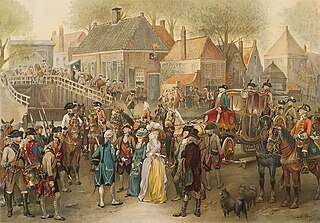
The Patriottentijd was a period of political instability in the Dutch Republic between approximately 1780 and 1787. Its name derives from the Patriots faction who opposed the rule of the stadtholder, William V, Prince of Orange, and his supporters who were known as Orangists.

Rutger Jan, Count Schimmelpenninck, Lord of Nyenhuis, Peckedam and Gellicum, was a Dutch jurist, ambassador and politician who served as Grand Pensionary of the Batavian Republic from 1805 to 1806. Historian Niek Sas called him the first Dutch liberal politician.

Laurens Pieter van de Spiegel was Grand Pensionary of Zeeland and, from 9 November 1787 to 4 February 1795, of Holland. He was an Orangist, which means that he was a supporter of Prince William V of Orange. He became grand pensionary of Holland when the Prussian army had reinstated William V in power in 1787. He fled to Germany in 1795, when the French defeated the Dutch army and an anti-Orangist revolution broke out. He died in Lingen, Prussia. Van de Spiegel was the last Grand Pensionary of the Republic of the Seven United Netherlands, which was replaced with the Batavian Republic modelled after the French revolutionary state.
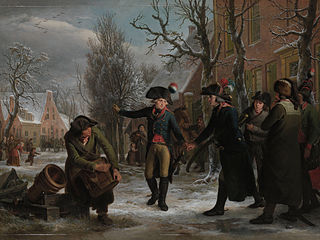
The Batavian Revolution was a time of political, social and cultural turmoil at the end of the 18th century that marked the end of the Dutch Republic and saw the proclamation of the Batavian Republic. The period of Dutch history that followed the revolution is referred to as the "Batavian-French era" (1795–1813) even though the time spanned was only 20 years, of which three were under French occupation under Napoleon Bonaparte.

Pieter Paulus was a Dutch jurist, fiscal (prosecutor) of the Admiralty of the Maze and politician. He was one of the ideologues of the Dutch Patriot movement and is considered by many Dutch as the founder of their democracy and political unity.

The Perpetual Edict was a resolution of the States of Holland passed on 5 August 1667 which abolished the office of Stadtholder in the province of Holland. At approximately the same time, a majority of provinces in the States General of the Netherlands agreed to declare the office of stadtholder incompatible with the office of Captain general of the Dutch Republic.

In the history of the Dutch Republic, Orangism or prinsgezindheid was a political force opposing the Staatsgezinde (pro-Republic) party. Orangists supported the Princes of Orange as Stadtholders and military commanders of the Republic, as a check on the power of the regenten. The Orangist party drew its adherents largely from traditionalists – mostly farmers, soldiers, noblemen and orthodox Protestant preachers, though its support fluctuated heavily over the course of the Republic's history and there were never clear-cut socioeconomic divisions.

The Batavian Revolution in Amsterdam refers to the transfer of power in the city of Amsterdam on 18 January 1795 to a Revolutionary Committee of the new Batavian Republic. The same day the stadtholder of the Dutch Republic, William V, Prince of Orange fled the country. Amsterdam was the first city that declared itself in the Batavian Revolution that brought about the Batavian Republic.

Aegidius van Braam was a Dutch naval officer who attained the rank of vice-admiral. When the Dutch Republic was overrun by French Revolutionary troops in 1795, he remained loyal to the House of Orange-Nassau and fled to England. Following the restoration in 1814, he was repatriated by King William I and received the hereditary noble title of jonkheer.

The Dutch States Party was a political faction of the United Provinces of the Netherlands. This republican faction is usually (negatively) defined as the opponents of the Orangist, or Prinsgezinde faction, who supported the monarchical aspirations of the stadtholders, who were usually members of the House of Orange-Nassau. The two factions existed during the entire history of the Republic since the Twelve Years' Truce, be it that the role of "usual opposition party" of the States party was taken over by the Patriots after the Orangist revolution of 1747. The States party was in the ascendancy during the First Stadtholderless Period and the Second Stadtholderless Period.

The Prussian invasion of Holland was a Prussian military campaign in September–October 1787 to restore the Orange stadtholderate in the Dutch Republic against the rise of the democratic Patriot movement.

Willem Aarnoud or Aarnout van Citters was a Dutch politician who served as the last Grand Pensionary of Zeeland. He was appointed to the role in 1788 and held it until 1795, when the Dutch Republic was overthrown and replaced by the Batavian Republic.
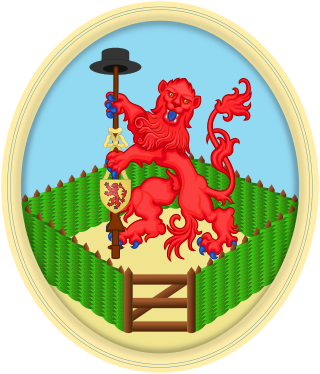
The Provisional Representatives of the People of Holland was the name given to the supreme governing body of the province of Holland, instituted after the Batavian Revolution, during the period in which the Netherlands was transitioning from the constitution under the Dutch Republic to the new constitution of the Batavian Republic. After the States General of the Batavian Republic had been replaced by the National Assembly of the Batavian Republic, in 1796, the Provisional Representatives, and similar bodies, in all Dutch provinces were abolished.
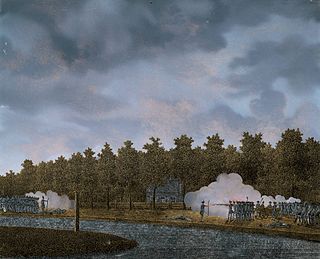
The Battle of Jutphaas, also known as the Battle of the Vaart or the Battle of Vreeswijk, occurred on 9 May 1787 on the banks of the Vaartsche Rijn canal near Jutphaas and Vreeswijk between Orangists and Patriots.
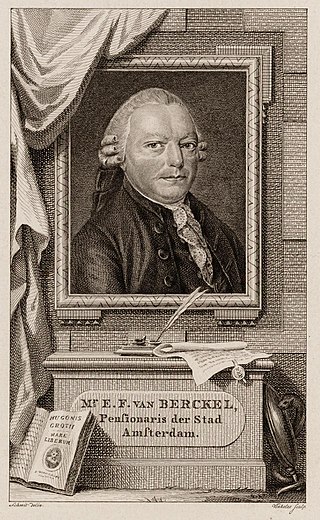
Engelbert François van Berckel was a Dutch politician during the Patriottentijd.
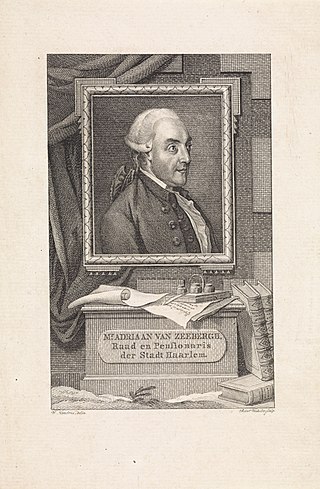
Adriaan van Zeebergh was a Dutch politician during the Patriottentijd.
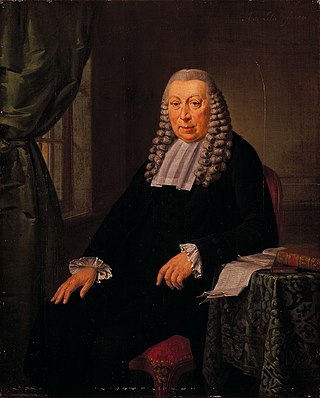
Hendrik Daniëlszoon Hooft, Ambachtsheer of Urk and Emmeloord was a Dutch politician during the Patriottentijd.

Joachim Rendorp, Vrijheer of Marquette was a Dutch politician of the Patriottentijd in the Dutch Republic.
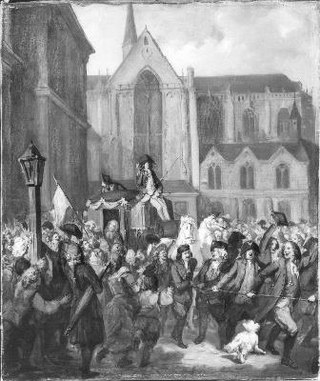
Willem Gerrit Dedel SalomonszoonAmbachtsheer of Sloten and Sloterdijk was a Dutch politician during the Patriottentijd in the Dutch Republic.